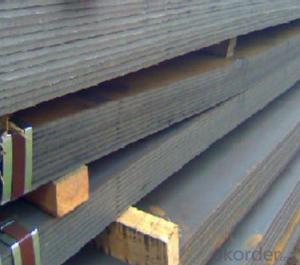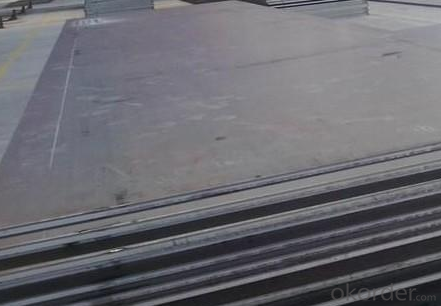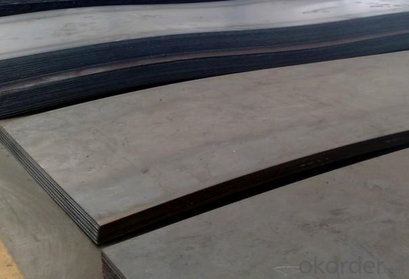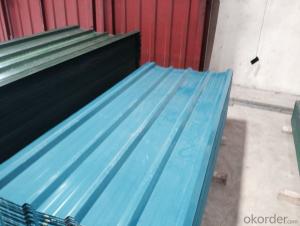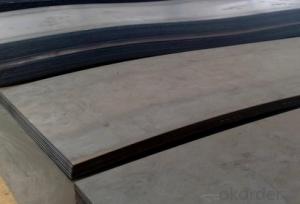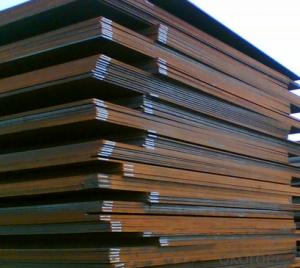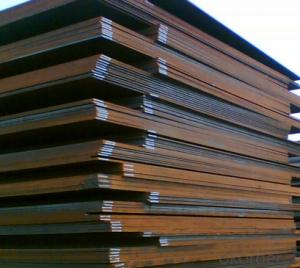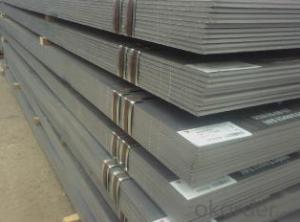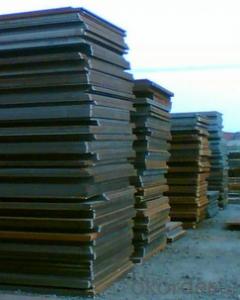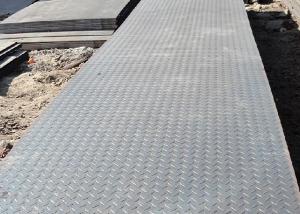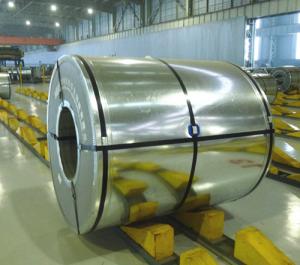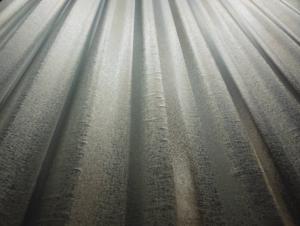Hot Rolled Carbon Steel Plate,Carbon Steel Sheet Q275, CNBM
- Loading Port:
- Qingdao
- Payment Terms:
- TT OR LC
- Min Order Qty:
- 10 pc
- Supply Capability:
- 30 pc/month
OKorder Service Pledge
OKorder Financial Service
You Might Also Like
Quick Details
| Standard: | AISI, ASTM, GB, JIS | Grade: | Q195,Q235,Q345,A36,C45 | Thickness: | 1.0-30MM |
| Model Number: | Q235,Q195,Q345 | ||||
| Type: | Steel Plate | Technique: | Hot Rolled | Surface Treatment: | Coated |
| Application: | Ship Plate | Special Use: | Silicon Steel | Width: | 30-2000mm |
| Length: | as your requirement | standard: | hot rolled | Surface: | Anti-rust oil |
Packaging & Delivery
| Packaging Details: | seaworthy packages or as customers' require |
| Delivery Detail: | within 15 days after the advance payment |
Hot rolled steel plate
1 carbon steel plate 3mm thick General information
| Product name | Type | Specification | Implementation of GB | ||
| thick | wide | long | |||
| Carbon structural steel | Q195,Q215, Q235A,Q235B, Q235C,Q255, Q275 | 4-120 | 1500-4500 | 6000-12000 | GB/T700-2006 |
| Low-alloy structural steel | Q295,Q345A, Q345B,Q2345C | 4-120 | 1500-4500 | 6000-12000 | BG/T1591-1994 |
| Quality carbon structural stee | 30-50 | 4-120 | 1500-4500 | 6000-12000 | BG/T699-1999 |
| Ship steel | CCSA,CCSB | 4-120 | 1500-4500 | 6000-12000 | materials and welding condition |
| CCSAH32,CCSAH36 CCSDH32,CCSDH36 | 4-120 | 1500-4500 | 6000-12000 | materials and welding condition or GB 712-2000 | |
| Boiler steel | 20g,22Mng, 16Mng,19Mng | 4-120 | 1500-4500 | 6000-12000 | GB 713-1997 |
| Pressure vessel steel | 1622Mng,20R, 15MnVR,15MnVNR | 4-120 | 1500-2700 | 6000-12000 | GB 6654-1996 |
| European standard plate
| S235JR,S235J0, S275JR,S275J0, S275JR2,S355JR, S355J0,S355J2 | 4-120 | 1500-4500 | 6000-12000 | EN 10025 |
| Japanese standard plate | SS400,SS400-B | 4-120 | 1500-4500 | 6000-12000 | JIS G3101-2004 |
2 carbon steel plate 3mm thick detail specification
Material:
A283Gr.D/A573Gr.65,A516Gr65,A516Gr70,A284Gr.D
SS400,SS300,CCSB A36,A32,LRA32,LRB,Q235
Q195,Q235,Q345,SS400,ASTM A36,E235B
Thickness: 4mm-120mm
width: 1500mm-4500mm
Length:2-10m ,accordingly
Thickness | 4-120mm |
Width | 1500-4500mm or as custom's request |
Length | 2-12m,as your requirment |
Technique | Cold rolled or hot rolled |
Surface treatment | Bare, galvanized coated or as customer's requirements. |
Standard | ASTM,EN,GB,JIS,GB |
Material | A283Gr.D/A573Gr.65,A516Gr65,A516Gr70,A284Gr.D SS400,SS300,CCSB A36,A32,LRA32,LRB,Q235 Q195,Q235,Q345,SS400,ASTM A36,E235B |
Terms of Payment | L/C or T/T |
Chemical composition | C≤0.004%;Si≤0.030%; Mn ≤0.17%;P≤0.012%; S≤0.010%; Fe balance |
Delivery Detail | within 30days once receive deposite or confirm L/C |
Packing | Standard export packing,or as requirement |
3 carbon steel plate 3mm thick application:
construction,machinery manufacturing, container manufacturing, shipbuilding, bridge construction. Can also be used to manufacture a variety of containers, the furnace shell, furnace plate, bridge and vehicle static steel plate, low alloy steel plate,shipbuilding plate, boiler plate, pressure vessel plate, pattern plate, tractor parts, automobile frame steel plate and welding components
- Q: What is a steel sheet?
- Manufactured through hot rolling or cold rolling, a steel sheet is a rectangular, flat, and thin piece of steel. It finds wide application in industries like construction, automotive, and manufacturing. Due to their versatility, steel sheets can be effortlessly cut, bent, and shaped to cater to specific needs. They are available in different sizes and thicknesses, and their exceptional durability and strength make them a preferred option for applications demanding structural integrity, corrosion resistance, and wear resistance. To augment their properties and safeguard against rusting, steel sheets can undergo further treatments such as galvanization or coating.
- Q: What is the typical elongation of a steel sheet?
- The typical elongation of a steel sheet varies depending on the specific grade and thickness of the sheet. However, on average, steel sheets can have an elongation of around 20-30% before they reach their breaking point.
- Q: Are the steel sheets resistant to warping or twisting?
- Yes, steel sheets are highly resistant to warping or twisting due to their inherent strength and rigidity.
- Q: How are steel sheets protected during transportation by sea?
- Steel sheets are protected during transportation by sea through various measures such as applying corrosion-resistant coatings, packing them in moisture-proof and weather-resistant materials, securing them with appropriate lashing and bracing, and using specialized shipping containers or vessels equipped with proper ventilation and humidity control systems. These measures ensure that the steel sheets remain intact, free from rust, and undamaged throughout the sea voyage.
- Q: Can steel sheets be used for food-grade applications?
- When using steel sheets for food-grade purposes, it is crucial to verify that they meet specific criteria. The food industry commonly employs stainless steel sheets due to their resistance to corrosion, durability, and ability to withstand high temperatures. Additionally, they are easy to clean and maintain, making them well-suited for food processing, storage, and transportation. For steel sheets to be deemed food-grade, they must exhibit a high level of purity and be free from any contaminants that may potentially leach into the food. Moreover, the steel should possess corrosion resistance, as any rust or corrosion can contaminate the food and present health risks. Alongside the material composition, the surface finish of the steel sheets plays a significant role in food-grade applications. Smooth and polished surfaces are preferred as they facilitate easier cleaning and prevent the accumulation of bacteria and other microorganisms. It is imperative to choose steel sheets that adhere to industry standards and regulations, such as those established by the Food and Drug Administration (FDA) in the United States or similar organizations in other countries. These standards guarantee that the steel sheets meet the necessary requirements for food safety. In summary, steel sheets can be utilized for food-grade purposes; however, it is vital to carefully select the appropriate type of stainless steel with the correct composition, surface finish, and compliance with relevant regulations to ensure the safety and quality of the processed or stored food.
- Q: How are steel sheets cleaned and maintained?
- Steel sheets can be cleaned and maintained using various methods depending on the specific requirements and conditions. Here are some common practices to clean and maintain steel sheets: 1. Regular cleaning: Steel sheets should be cleaned regularly to remove dust, dirt, and other debris that may accumulate on the surface. This can be done using a soft cloth or sponge with mild soap or detergent and warm water. Avoid using abrasive cleaners or scrub brushes that can scratch the surface. 2. Rust removal: If rust spots appear on the steel sheets, they should be promptly removed to prevent further corrosion. Rust can be removed using a wire brush, sandpaper, or a rust remover solution. Afterward, the area should be thoroughly cleaned and dried. 3. Protective coating: Applying a protective coating can help prevent rust and corrosion, especially for steel sheets exposed to harsh environments or moisture. This can be done using paint, varnish, or a specialized anti-corrosion coating. The coating should be applied according to the manufacturer's instructions and reapplied periodically as needed. 4. Proper storage: Steel sheets should be stored in a dry and well-ventilated area to prevent moisture buildup and corrosion. They should be kept away from direct contact with the ground and other metals to avoid galvanic corrosion. Additionally, using covers or protective wraps can further safeguard the sheets from dust and other contaminants. 5. Periodic inspection: Regularly inspecting steel sheets for any signs of damage, such as dents, scratches, or cracks, is essential. If any damage is found, it should be repaired promptly to prevent further deterioration. 6. Professional maintenance: For large-scale or complex steel sheet installations, it may be necessary to hire professional maintenance services. These experts have the knowledge, tools, and experience to handle more extensive cleaning, maintenance, and repairs. By following these cleaning and maintenance practices, steel sheets can maintain their integrity, appearance, and performance over time.
- Q: Are the steel sheets perforated or solid?
- The steel sheets are perforated.
- Q: What are the different hardness levels available for steel sheets?
- The different hardness levels available for steel sheets typically range from soft (low hardness) to hard (high hardness). Some common hardness scales used for steel sheets include Rockwell, Brinell, and Vickers. These scales provide different ways to measure and express the hardness of steel, allowing users to choose the appropriate level based on their specific needs and applications.
- Q: What is galvanized steel sheet?
- Galvanized steel sheet is a steel type that has been given a protective layer of zinc to prevent corrosion. To achieve this, the steel sheet is immersed in molten zinc, resulting in a strong bond between the zinc and the steel surface. As a result, a long-lasting and resilient material is formed, which is highly resistant to rust and other forms of corrosion. The zinc coating acts as a sacrificial barrier, meaning that it will corrode before the steel beneath it. This property makes galvanized steel sheet an ideal option for outdoor applications or environments with high humidity or exposure to moisture. It is widely used in industries such as construction, automotive manufacturing, and household appliance production. Galvanized steel sheets have a distinct silver-gray appearance due to the presence of the zinc coating. They offer exceptional strength and durability, making them suitable for a variety of structural uses. Moreover, galvanized steel sheets require minimal maintenance and upkeep to preserve their corrosion resistance. To summarize, galvanized steel sheet is a steel type that has been coated with zinc to protect it from corrosion. This coating provides exceptional durability and resistance to rust, making it a popular choice in various industries.
- Q: Can steel sheets be used for manufacturing shipping containers?
- Yes, steel sheets can be used for manufacturing shipping containers. Steel is a durable and strong material that provides excellent structural integrity, making it ideal for constructing shipping containers. Steel sheets are typically used to create the walls, roof, and floor of the container, ensuring the container can withstand the rigors of transportation and protect the goods inside. Additionally, steel is resistant to various weather conditions, corrosion, and pests, making it a reliable choice for shipping container manufacturing.
Send your message to us
Hot Rolled Carbon Steel Plate,Carbon Steel Sheet Q275, CNBM
- Loading Port:
- Qingdao
- Payment Terms:
- TT OR LC
- Min Order Qty:
- 10 pc
- Supply Capability:
- 30 pc/month
OKorder Service Pledge
OKorder Financial Service
Similar products
Hot products
Hot Searches
Related keywords
